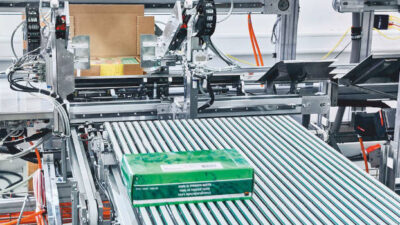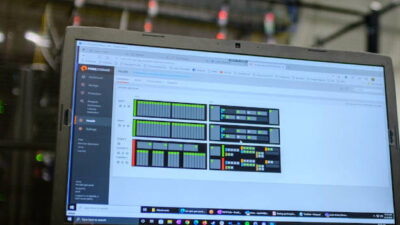Industrial-grade I/O devices from Wago are helping out at the 2010 Olympic and Paralympic Winter Games in Vancouver, Canada.
INSIDE – List of automation and controls used Wago RJ-45 interface modules link each suite to a Wago Ethernet TCP/IP 2-Port Programmable Fieldbus Controller, which can collect, track, measure, calculate and report data for up to 20 iEMS-equipped Olympic village suites.
|
Industrial-grade I/O devices from Wago are helping out at the 2010 Olympic and Paralympic Winter Games in Vancouver, Canada. For the 21st Winter Olympics, the Vancouver Organizing Committee is showcasing Canada’s commitment to unity and sustainability. While nearly 7,000 athletes from more than 80 countries are going for the gold, Vancouver went for the green instead.
Millennium Water, site of the 2010 Olympic and Paralympic Village, was conceived as an icon of sustainability. Employing a holistic approach, developers created a climate-responsive design with low-impact building materials and a strategic, I/O-driven energy reduction plan. To significantly reduce energy consumption, developers collaborated with the efficiency experts at Enerpro Systems Corp. and technology partner, Wago.
To minimize energy consumption, Olympic village developers drew on Enerpro’s Integrated Energy Management System (iEMS) to oversee HVAC and domestic hot water usage within each apartment-style suite. iEMS represents Enerpro’s 14 years in energy management and expertise with I/O-driven technology.
The premise behind iEMS is simple: for even the greenest building to be fully effective, it must encourage greener behavior. Thus, iEMS was placed in 1,100 Olympic Village suites to "coach" occupants into greener behavior. Similar in principle to a hybrid’s "Eco" driving mode, a wireless in-suite iEMS display encourages occupants to maintain or reduce energy consumption. Mimicking traffic signals, a green LED reinforces positive, eco-friendly behavior. If consumption climbs, iEMS urges moderation via amber LEDs; if consumption continues unabated, a red LED chastises occupants. iEMS then calculates and displays the billable amount, based on local pricing, in the wireless HMI display. This directly ties an occupant’s sense of environmental stewardship to their sense of financial responsibility.
"With iEMS, we offered a couple of ways [for Millennium Water] to earn additional LEED points via measurement/verification and innovation," Farina said.
Easy-to-use automation
While energy monitoring is not new, Enerpro expanded it by incorporating a simple, real-time interface.
"Our original concept was taking digital controllers – which are now smaller, smarter and have greater capacity – and work those into a monitoring system," Farina said. "What’s important is the human factor: we dealt with the real-life situation – a marriage between technical capability and humans. What good is a system if you install it, and nobody knows how to use it?"
Keeping this in mind, Dalibor Wiedermann, Enerpro’s technical specialist, adapted Wago-I/O into iEMS. His rationale: the modular I/O system and its programming capabilities would streamline iEMS, keeping it as simple as possible for both installers and end-users.
Automation
component
summary – Temperature sensors |
Details about
Millennium Water,
the Olympic villageBronze, Silver, Gold and Green: Situated in the Southeast False Creek development, a reclaimed industrial brownfield, the 1.5 million sq. ft Millennium Water Project boasts: 1,100 residences, 45,000 sq. ft of meeting spaces and restaurants for 3,000+ Olympic guests. Currently an official Olympic site, Millennium Water will revert to Vancouver in April 2010. By 2020, Millennium Water will swell into a six million sq. ft sustainable neighborhood featuring commercial zones and 5,000 residences for 16,000 Vancouverites. According to Vancouver’s Sustainability Office, buildings are responsible for 54% of all greenhouse gases in the city. Given Millennium Water’s size, developers sought Gold certification from the Leadership in Energy and Environmental (LEED) council. "With Millennium Water, we all set out to do the right thing; now, it is North America’s largest LEED Community," Enerpro president Nick Farina explained. Farina credited Millennium Water’s innovation to Roger Bayley, design manager for Millennium Water: the Southeast False Creek Vancouver 2010 Olympic and Paralympic Village. iiEMS provides another benefit: fair cost allocation. When Vancouver residents move into Millennium Water in April 2010, they will only pay for what they use. Fair cost-allocation has driven residents to adopt iEMS in other applications, creating a greater sense of personal responsibility. "Occupants feel much better once they realize what the technology is aimed at doing," according to those involved with the project. www.enerprosystems.com Olympic Winter Games : February 12 to 28, 2010 Paralympic Winter Games : March 12 to 21, 2010 www.tourismvancouver.com/visitors /about_vancouver/2010_olympics/2010_olympics |
Using a Domestic Hot Water (DHW) sensor, BTU meter and a Current Transformer, iEMS collects heating/cooling energy (kWh), domestic hot and cold water monitoring (US gal.) and electricity (kWh) entering each suite. Wago’s 4-channel analog input modules (0/4-20 mA) and three-phase power measurement I/O module are wired to current transducers and sensors in select water pipes. A Wago Serial Interface RS-232 C module then uses Modbus to collect data from water and BTU meters via serial communication.
Automation design
Wago RJ-45 interface modules link each suite to a Wago Ethernet TCP/IP 2-Port Programmable Fieldbus Controller. Each controller can collect, track, measure, calculate and report data for up to 20 iEMS-equipped suites. Enerpro programmed current energy rates – determined by local jurisdictions – into each Wago PLC, enabling the PLCs to calculate and store energy consumption values for each suite.
"Wago’s Ethernet controller is our first point of calculation," Farina explained. "Their PLC is a‘master,’ collecting data from meters and forwarding it to an Energy Aware display – it uses one protocol to collect data and other to send via Internet to us."
Enerpro then electronically stores all data. After calculation, consumption usage and associated costs are wirelessly transmitted to the in-suite HMI.
iEMS is modular and scalable – it can suit smaller, multi-unit buildings and complexes such as Millennium Water. However, this meant the I/O used must also be modular, as each panel for each building accommodates a varying number of suites. Enerpro also required programming freedom to interface with European energy sensors. Farina said Wago’s dual-port Ethernet PLC has program libraries for serial communication, which easily integrate varying communication protocols, such as M-BUS, Modbus RTU and TCP/IP. Engineers were also able to rely on the PLC for data logging and trends.
"Wago eliminated system duplicity – everything from the simple to sophisticated," Farina added. "With energy and water, it’s a control strategy. We collect energy data, store it and Wago eliminates redundant communication hardware and software. The PLC’s built-in software, and its ability to eliminate communication redundancy, worked so well. It became a cornerstone of this strategy."
Through proper usage, Enerpro projects iEMS could reduce gas usage by 20-40% and water usage by 40-55%, saving nearly $400/unit in multi-resident buildings over one year.
"We’ve seen iEMS installs where water consumption over one year is 60% lower than a virtually identical building without iEMS," Farina noted. "We’ve even seen 72% less gas usage for large, multi-family residences equating to nearly $25,000 saved annually."
Going beyond traditional energy sources, Enerpro is developing future iEMS iterations to site specific energy production from solar, wind, geothermal and even hydrogen. Partnering with the University of British Columbia, Enerpro is adapting iEMS into a neighborhood-wide system. The system will link several single-family homes into one energy reduction network and will rely on Wago’s PLC for networking, extensive data logging and comprehensive calculations. As Enerpro sees it, it will take a whole village, whether full of Olympians or not, to create lasting change.
Discussion thread to continue below : How could these automation tools benefit your industrial application?
Read about energy management and I/O modules:
– Rockwell Automation announces sustainable manufacturing portfolio ;
– Siemens and Viridity Energy form alliance aimed at smart grid implementations ;
– Wago implementation tips for I/O-based controllers ;
See other Olympic automation applications:
– Automated Olympics, 2008 ; and
– Hydraulic driven 68-story Ferris wheel begun for ’08 Olympics .
– Paul Garcia is creative / technical writer at Wago Corp., www.wago.us; edited by Mark T. Hoske, editor in chief, Control Engineering , www.controleng.com.



